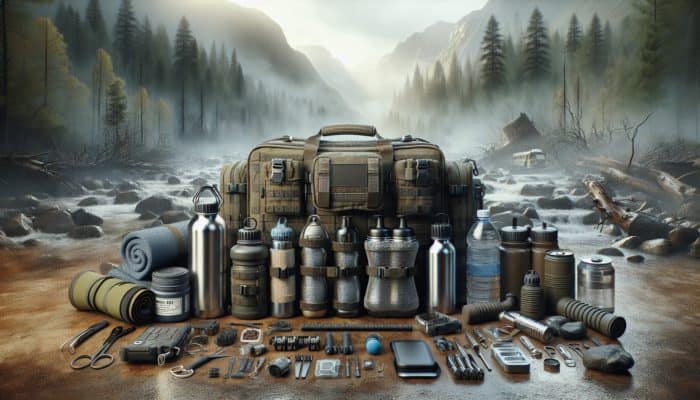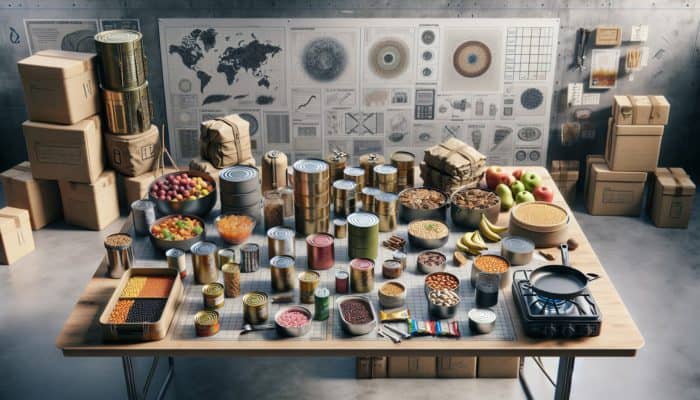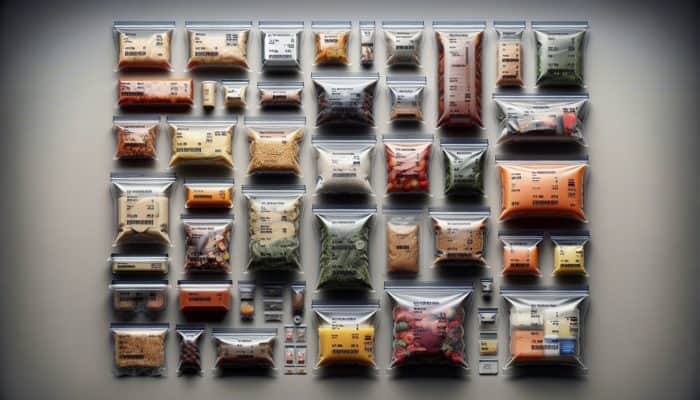The Critical Importance of Water and Hydration in Survival Situations
Bug-Out Bag Checklist: Survival frequently depends on fulfilling the most basic requirement: water. When assembling a bug-out bag checklist, it is vital to prioritise water and hydration resources. The availability of safe drinking water can be the defining factor between life and death in emergency scenarios, making it imperative to prepare adequately. Your bug-out bag checklist should include a variety of methods for storing and purifying water, ensuring you have enough to last at least 72 hours of unpredictability and uncertainty.
Choosing Durable Water Bottles for Your Survival Kit

Selecting robust and portable water bottles is crucial for any bug-out bag checklist. Select high-quality materials, such as stainless steel or BPA-free plastic, that can withstand rough handling and extreme temperatures. Carrying sufficient water for a minimum of 72 hours, ideally around three litres per person per day, ensures you remain hydrated during stressful circumstances. Consider using collapsible water bottles that conserve space when empty, thus making your bag lighter and easier to manage.
Beyond size and durability, opt for bottles with a wide mouth for effortless filling and cleaning. Many brands now provide bottles equipped with built-in filters that can purify water sourced from rivers or lakes, enabling access to fresh water in diverse environments. Remember to stock additional bottles to store water acquired from various sources, particularly when traveling through regions with limited access to clean water.
Essential Water Purification Techniques for Emergency Preparedness
In times of crisis, dependable water purification methods are indispensable components of your bug-out bag checklist. Incorporate water purification tablets or a portable filter as a vital backup to your water supply. Water purification tablets can efficiently neutralise harmful bacteria and parasites, making water drawn from questionable sources safe for consumption. These tablets are lightweight, user-friendly, and possess a long shelf life, making them an excellent addition to your survival kit.
On the other hand, portable filters can provide immediate access to safe drinking water. Brands such as LifeStraw and Sawyer offer compact filters capable of cleansing water from rivers, lakes, or streams, removing up to 99.99% of contaminants. Filters can present a more sustainable option than relying solely on tablets, especially during prolonged emergencies. By integrating both methods into your bug-out bag checklist, you can secure a continuous supply of safe water, which is critical for survival.
Hydration Packs: A Convenient Solution for On-the-Go Hydration
When mobility is paramount, hydration packs offer a practical solution for maintaining hydration while on the move. These packs enable you to carry water comfortably and efficiently, making them indispensable for individuals fleeing from danger or navigating challenging terrains. Look for hydration packs that feature a built-in reservoir and a hose for easy sipping while walking or running, ensuring you remain hydrated without sacrificing speed.
Many hydration packs also include extra compartments for storing essential items, such as first aid kits, snacks, or navigation tools, thereby enhancing their multifunctionality. This feature can help you save valuable space in your bug-out bag checklist while ensuring that your hydration needs are seamlessly met. As you explore various hydration options, consider the specific demands of your environment and anticipated travel conditions, optimising your pack for a successful and sustainable escape.
Food and Nutrition: Essential Supplies for Energy Maintenance

In emergencies, maintaining energy levels is crucial. Packing appropriate food and nutrition options in your bug-out bag checklist can significantly influence your resilience and morale. Focus on non-perishable foods, cooking equipment, and effective food storage solutions to prepare for a range of situations, from short-term evacuations to extended survival scenarios.
High-Energy Non-Perishable Foods for Survival
High-energy non-perishable foods are at the forefront of any effective bug-out bag checklist. Selecting options such as energy bars, ready-to-eat meals, and canned goods ensures you have a variety of nutrients to sustain yourself. Energy bars are lightweight and calorie-dense, making them an ideal choice for quick snacks on the go. Look for those enriched with protein, fibre, and essential vitamins to keep your body fuelled during high-stress situations.
Ready-to-eat meals, such as MREs (Meals Ready to Eat), are another excellent choice due to their long shelf life and balanced nutrition. These meals often come in packaging that retains heat, making it easy to enjoy a warm dish without the need for cooking. Canned goods, including vegetables and fruits, provide vital vitamins and minerals. Opt for cans with pull-tab lids to save precious time and energy during an emergency. With a diverse selection available, ensuring you have a balanced assortment of foods in your bug-out bag checklist can significantly enhance your chances of survival.
Cooking Equipment: Enhancing Meal Preparation Capability
Cooking equipment enhances your ability to prepare hot meals, which can significantly boost morale and nutrition during emergencies. A portable stove is an indispensable tool in any bug-out bag checklist, as it allows you to heat meals, boil water for purifying, and create comforting foods that can uplift spirits during trying times. Look for lightweight, compact stoves that fuel easily, such as those that use propane or butane canisters, which can be conveniently stored within your bag.
In addition to a portable stove, ensure you include essential utensils such as a lightweight pot, a spatula, and a multi-tool that incorporates a knife. These tools will facilitate effective meal preparation, ensuring you can cook a variety of dishes with minimal hassle. As you plan your menu, consider including dehydrated or freeze-dried foods, which can be rehydrated with boiling water, making for an easy and nutritious meal. With these cooking essentials packed, you’ll be well-equipped to nourish both yourself and your companions during emergencies.
Effective Food Storage Solutions for Prolonged Freshness

Proper food storage is vital for maintaining the freshness and safety of your provisions in your bug-out bag checklist. Resealable bags and airtight containers can shield food from moisture, pests, and the elements, ensuring that your food supply remains viable for a longer period. When packing, consider portion sizes that are appropriate for your group, which will help minimise waste and maximise efficiency.
Label your storage containers with the contents and expiration dates, allowing for easy access and rotation of supplies. Vacuum-sealing options are also beneficial for longer-term storage, significantly extending the shelf life of your food items. In outdoor settings or during an emergency, the right food storage solutions can keep your meals fresh and encourage a positive outlook amidst the challenges of survival.
Strategies for Shelter and Warmth in Uncertain Environments
In the great unknown, your shelter and warmth options can be critical to survival. Establishing a solid shelter and warmth strategy in your bug-out bag checklist can provide safety from harsh environmental conditions. Prioritise lightweight, portable solutions that can be set up quickly, offering both protection and comfort during emergencies.
Choosing the Right Tents and Tarps for Shelter
When confronted with unpredictable weather, lightweight, waterproof tents and tarps are paramount in your bug-out bag checklist. Tents provide essential shelter from rain, wind, and cold temperatures, while tarps offer versatility for multiple uses, from covering equipment to creating makeshift shelters. Look for tents that are easy to assemble and compact, allowing you the mobility you need during emergencies.
Material choice is critical; consider tents made from durable, water-resistant fabrics that can withstand various weather conditions. Tarps can be fashioned into a variety of structures, providing shade, ground cover, or even temporary walls. Learning basic shelter-building techniques can enhance your survival skills and enable you to adapt your setup to the environment. The right shelter options not only protect you from the elements but also provide a degree of comfort and security during challenging times.
Investing in Quality Sleeping Bags for Cold Nights
A warm sleeping bag can be a lifesaver during cold nights, making it an essential item on your bug-out bag checklist. Select bags rated for low temperatures to ensure adequate warmth, especially if you anticipate encountering extreme conditions. Synthetic materials often provide superior insulation and moisture resistance, making them suitable for damp environments.
Consider lightweight options that pack down small, allowing for easier transport. Additionally, a sleeping pad can provide insulation from the cold ground and enhance overall comfort. The right sleeping gear can make a significant difference in your ability to rest and recover, ultimately enhancing your resilience during a survival situation.
Insulating Materials: Critical for Maintaining Body Heat
Packing insulating materials, such as blankets and thermal wear, can help maintain body heat in harsh conditions, making them essential components of your bug-out bag checklist. Space blankets are ultra-lightweight, compact, and provide excellent insulation against the cold, reflecting heat to your body and helping to prevent hypothermia.
Thermal wear, including base layers, socks, and hats, plays a crucial role in regulating body temperature. Layering your clothing can trap heat more effectively, allowing you to adapt to changing temperatures throughout the day. When preparing for emergency scenarios, consider the specific environmental conditions you may encounter, and pack insulation materials that will keep you warm and comfortable.
First Aid and Medical Supplies: Essential for Health Management
A well-stocked first aid kit can be a game-changer during emergencies, particularly when injuries or health issues arise. Including a comprehensive selection of medical supplies in your bug-out bag checklist will empower you to manage minor injuries and enhance safety for you and your group in critical situations.
Essentials for a Basic First Aid Kit
An effective first aid kit should encompass essential items such as bandages, antiseptics, and pain relievers to address minor injuries and ailments. Stock your bug-out bag checklist with various sizes of adhesive bandages, gauze pads, and medical tape for wound care. Antiseptic wipes and ointments can help prevent infections, while over-the-counter pain relievers, such as ibuprofen or acetaminophen, can alleviate discomfort from injuries or illnesses.
Consider adding additional items such as a cold pack for swelling, a compress for bleeding, and burn ointment for potential injuries. Tailor your first aid kit to your specific needs, especially if you or your group members have chronic medical conditions or allergies that may require unique supplies. Ensuring that your first aid kit is comprehensive and accessible can provide peace of mind and enhance safety during emergencies.
Carrying Necessary Medications for Health Security
Carrying a supply of necessary medications is vital for your bug-out bag checklist. If you or a member of your group relies on prescription medications, ensure you have enough to last through an emergency, alongside over-the-counter remedies for common health issues such as allergies, gastrointestinal problems, or headaches.
Store these medications in waterproof containers to protect them from the elements, and keep a copy of any prescriptions handy, as this can facilitate refills if needed. Regularly review and update your medication supply by replacing expired items and adjusting dosages as needed. Proper planning in this area can significantly enhance your overall health and safety during difficult circumstances.
Incorporating Basic Medical Tools for Effective Care
In conjunction with your first aid kit and medication supplies, equipping yourself with basic medical tools can enhance your ability to administer care when needed. Include items like scissors, tweezers, and a thermometer in your bug-out bag checklist. Scissors can assist with cutting tape or gauze, while tweezers can be invaluable for removing splinters or debris from wounds.
A thermometer is essential for monitoring body temperature when illness arises, helping you make informed decisions about seeking further medical assistance. Additionally, consider adding a first aid manual or guide to your kit, which will provide you with essential knowledge in critical moments. Having the right tools and resources can empower you to manage medical issues effectively and increase your chances of a successful outcome.
Maintaining Emergency Contact Information for Quick Access
Keeping a list of emergency contacts readily available is a crucial yet often-overlooked aspect of a comprehensive bug-out bag checklist. Ensure your list includes essential contacts such as doctors, hospitals, and family members for quick access during medical emergencies. Store this information in a waterproof container or on a waterproof card to protect it from the elements.
In an emergency, having quick access to medical professionals can significantly enhance your safety and well-being. Additionally, keep records of any pertinent medical history, allergies, or pre-existing conditions for yourself and family members, as this information can be invaluable if you require medical assistance. This proactive approach could be lifesaving during critical situations and highlights the importance of thorough preparation.
Empowering Your Group with First Aid Training
Having at least one person in your group trained in first aid is a crucial component of your bug-out bag checklist. First aid training equips you with the skills necessary to handle medical situations effectively, ensuring injuries and health issues are addressed promptly. Look for local classes offered by organisations such as the Red Cross, community centres, or hospitals, and encourage group members to participate.
In addition to formal training, consider studying basic first aid resources or manuals to familiarise yourself with essential techniques and best practices. Knowing how to perform CPR, manage bleeding, or handle an allergic reaction can significantly impact your ability to provide care during emergencies. Empowering yourself and your group with first aid knowledge promotes safety and fosters a culture of preparedness.
Effective Communication and Navigation Strategies for Emergencies
In emergencies, effective communication and navigation can be your lifelines. Including reliable tools in your bug-out bag checklist will ensure you can stay informed and find your way, regardless of the circumstances you encounter.
Radios and Chargers: Staying Updated in Crisis Situations
Including a hand-crank or solar-powered radio in your bug-out bag checklist is essential for staying informed about news and emergency alerts. These radios allow you to receive crucial information about changing conditions, evacuation orders, or rescue efforts. Choose a model that is compact, lightweight, and easy to operate, ensuring you can access vital information irrespective of technology failures.
Including additional charging options, such as portable solar chargers or power banks, will help keep your devices functional when you need them most. A charged phone can serve as a communication lifeline, but it’s crucial to have alternatives when traditional methods fail. Equipping your bag with the right communication tools prepares you for various scenarios, allowing you to remain connected and informed in emergencies.
Packing Maps and Compasses for Off-Grid Navigation
While technology often guides our navigation, packing detailed maps and a reliable compass in your bug-out bag checklist is essential for off-grid scenarios. Maps provide a broader context of your surroundings, including roads, trails, and potential hazards, while compasses can help you maintain direction without relying on electronic devices.
Familiarise yourself with the use of your compass and practice reading maps before emergencies arise. Understanding how to correlate topographical features with maps can enhance your navigation skills and boost your confidence while travelling through unfamiliar areas. In various environments worldwide, getting lost can have dire consequences; having these tools and skills at your disposal can greatly enhance your chances of safety.
The Importance of Carrying Signal Devices for Emergency Situations
Carrying signal devices such as whistles, mirrors, and flares is a critical addition to your bug-out bag checklist. These items can serve as an effective means of attracting attention during emergencies, especially when other forms of communication are unavailable. Whistles are lightweight and can produce loud sounds that carry over long distances, making them ideal for signalling your location.
Mirrors can reflect sunlight and create visible signals, while flares can provide a bright visual cue for search and rescue teams. Understanding how to use these signal devices effectively can be a lifesaver in emergencies. Ensure all group members are knowledgeable about how and when to use these signals to maximise their effectiveness in attracting help or navigating safely.
Clothing and Personal Items: Key Components for Comfort and Safety
In survival situations, having the right clothing and personal items is crucial for comfort and safety. Carefully curating your bug-out bag checklist with essential clothing, hygiene products, and personal documentation can significantly improve your chances in challenging scenarios.
Weather-Appropriate Clothing for All Conditions
Packing weather-appropriate clothing is vital for your bug-out bag checklist, as temperatures can fluctuate dramatically during emergencies. Layering is a key strategy that allows you to adjust accordingly based on changing conditions. Start with moisture-wicking base layers that keep sweat away from your body, followed by insulating layers for warmth, and finish with waterproof outerwear to protect against rain and wind.
Consider including a lightweight, packable jacket and thermal socks to keep your extremities warm. Accessories such as gloves and hats can also add extra insulation. As you prepare your bag, evaluate the specific climate conditions you may encounter and ensure your clothing choices are versatile enough to adapt to various scenarios. The right clothing and layering system can significantly impact your ability to endure challenging weather conditions.
Hygiene Products: Maintaining Cleanliness in Emergency Situations
Amid chaos, personal hygiene should not be neglected. Including hygiene products in your bug-out bag checklist can help maintain health and morale during emergencies. Pack items such as soap, toothpaste, toothbrushes, and sanitizers to keep yourself clean and reduce the risk of illness.
Consider travel-sized containers for ease of packing and portability. Biodegradable products can be a sustainable choice, ensuring minimal environmental impact during your travels. Maintaining hygiene is crucial not only for physical health but also for mental well-being, particularly during high-stress situations. Keeping a clean and healthy routine can make a substantial difference in overall morale and comfort.
Essential Personal Documents for Emergency Preparedness
Carrying personal documents in a waterproof container is an essential aspect of your bug-out bag checklist. Include identification, medical records, and cash to ensure you are prepared for various scenarios. Having copies of important documents can facilitate access to necessary services or assistance during emergencies.
Store these documents in a format that allows for easy retrieval and organisation. Consider using a waterproof pouch that can be easily packed within your bag without taking up excessive space. The importance of having accessible personal documents cannot be overstated, as they can aid your recovery and resilience in the aftermath of an emergency.
Investing in Comfortable Footwear for Mobility
Sturdy footwear is perhaps one of the most critical items in your bug-out bag checklist. When faced with the need to evacuate or navigate challenging terrains, comfortable and durable shoes or boots are paramount. Look for models that provide strong ankle support, cushioning, and waterproofing options to protect against the elements.
Consider the specific environments you may encounter and select footwear that strikes a balance between comfort and function. Packing an extra pair of socks can also go a long way in preventing blisters and maintaining foot comfort during long journeys. Prioritising footwear that you can rely on will enhance your mobility and resilience during emergencies.
Travel Accessories to Enhance Comfort During Your Journey
Travel accessories can enhance comfort during your journey, making them valuable additions to your bug-out bag checklist. Including items like a travel pillow, eye mask, and earplugs can significantly improve your ability to rest during stressful situations. A travel pillow can provide essential neck support during sleep, while eye masks can help block out light in unfamiliar environments.
Earplugs can help reduce distractions from noise, allowing for a better night’s rest. These simple additions can promote better sleep, which is vital for maintaining mental clarity and stamina during emergencies. By focusing on comfort and quality of rest, you can enhance your overall well-being and readiness for the challenges ahead.
Essential Tools and Equipment for Survival
A well-rounded arsenal of tools and equipment can drastically improve your chances of survival during emergencies. Including versatile devices in your bug-out bag checklist equips you with the means to tackle various tasks and challenges as they arise.
Multi-Tools: Versatile Solutions for Various Tasks
Multi-tools are invaluable items to include in your bug-out bag checklist, offering versatility for a plethora of tasks. A quality multi-tool typically encompasses various features, such as pliers, knives, can openers, and screwdrivers. These tools can be utilised for everything from food preparation to repairing gear, making them essential for survival situations.
When selecting a multi-tool, opt for one that feels comfortable in your hand and is made of durable materials. Brands like Leatherman and Gerber offer well-regarded options that have proven themselves over time. Having a multi-tool at your fingertips can empower you to tackle a wide range of challenges, enhancing your self-sufficiency in emergencies.
Flashlights and Lanterns: Essential Light Sources for Nighttime Safety
Reliable light sources are essential for visibility at night, making flashlights and lanterns critical components of your bug-out bag checklist. Select models that are lightweight, compact, and energy-efficient, ensuring they will withstand extended periods of use. LED flashlights are an excellent option due to their longevity and brightness.
Consider including extra batteries or a solar-powered lantern for long-term illumination. Lanterns can provide ambient light, making them ideal for cooking or working in camp. Ensuring you have reliable light sources can enhance your safety and efficiency during nighttime operations, allowing you to navigate effectively in the dark.
The Necessity of Ropes and Paracord in Survival Situations
Strong, versatile cordage is a must-have in your bug-out bag checklist. Ropes and paracord can be used for securing gear, creating shelters, or even fashioning makeshift splints for injuries. Paracord is lightweight yet incredibly strong, making it an ideal choice for survival situations where strength and portability are paramount.
Consider including a significant length of paracord, as it can be cut and used for various tasks. Learning basic knot-tying techniques can also enhance your ability to utilise this resource effectively. Having reliable cordage on hand enables you to solve many practical problems, making it an essential addition to your survival kit.
Ensuring Safety and Security in Emergencies
Safety and security are paramount in emergencies, and including essential items in your bug-out bag checklist can provide peace of mind. Equipping yourself with self-defense tools, fire starters, and other security measures helps ensure that you are prepared for unforeseen challenges.
Self-Defense Tools: Enhancing Personal Security
Including self-defense tools in your bug-out bag checklist can enhance your security during emergencies. Non-lethal options such as pepper spray provide a reliable means of self-defense that can deter potential threats while minimizing harm.
Consider the local laws and regulations regarding self-defense tools before packing them. Additionally, please familiarise yourself with their use to ensure confidence and effectiveness in critical situations. Taking personal security seriously can create a sense of empowerment, allowing you to navigate emergencies with greater assurance.
Fire Starters: Essential for Warmth and Cooking
Fire starters are essential for warmth, cooking, and signalling in emergencies. Including waterproof matches, lighters, and fire starters in your bug-out bag checklist ensures you have reliable means to create fire. Fire can boost morale, provide warmth, and enable you to prepare food, making it an invaluable resource in survival situations.
Opt for compact, lightweight options that can be carried easily within your bag. Learning various fire-starting techniques, such as friction or using kindling, can enhance your ability to create warmth when traditional methods fail. Mastering the art of fire-making can significantly improve your comfort and safety during emergencies.
Frequently Asked Questions about Bug-Out Bags
What is the purpose of a bug-out bag?
A bug-out bag serves as a portable emergency kit designed to provide essential supplies for survival in the event of a disaster or evacuation.
How long should a bug-out bag be prepared for?
A well-equipped bug-out bag should contain sufficient supplies for at least 72 hours, ensuring you have food, water, and other essentials to sustain yourself during emergencies.
What are the essential items to include in my bug-out bag?
A comprehensive bug-out bag should include water and purification methods, food and nutrition supplies, first aid items, communication tools, personal hygiene products, and other essential items.
How frequently should I check my bug-out bag?
Regularly inspect your bug-out bag every six months to replace expired items, update personal documents, and assess your supplies for any changes in needs.
Is it possible to customise my bug-out bag?
Absolutely! Your bug-out bag should be tailored to your unique needs, environment, and any specific circumstances you may encounter.
Is a first aid kit necessary in my bug-out bag?
Yes, including a well-stocked first aid kit is crucial for addressing minor injuries and health issues during emergencies.
What type of food is best suited for a bug-out bag?
Non-perishable foods such as energy bars, canned goods, and ready-to-eat meals are ideal for packing in a bug-out bag due to their long shelf life and nutritional value.
What is the significance of water purification?
Water purification is vital to ensure access to safe drinking water from various sources, preventing illness from contaminated water sources.
How do I select the appropriate clothing for my bug-out bag?
Choose weather-appropriate clothing that allows for layering, focusing on moisture-wicking and insulation materials to keep you comfortable in changing conditions.
What tools should I ensure are in my bug-out bag?
Essential tools for your bug-out bag include multi-tools, flashlights, paracord, and reliable navigation instruments to enhance your survival capabilities.
Explore our world on X!
Survival Radio Options: Essential Gear for Emergencies
Comprehensive Guide to Different Types of Survival Radios Portable Handheld Radios for Emergency Situations Survival Radio Options: Portable handheld radios are essential components of any effective survival strategy, providing unparalleled portability and user-friendliness during emergencies. These devices are specifically engineered to be lightweight, making them perfect for activities like hiking, camping, or preparing for unforeseen […]
Emergency Radio Picks: Your Universal Survival Guide
Comprehensive Guide to Emergency Radio Picks: Stay Informed During Crises What Are Emergency Radio Picks and Their Significance? Emergency Radio Picks: These devices are meticulously engineered to receive important broadcasts during crises, ensuring that individuals remain updated when standard communication channels fail. These radios are indispensable tools that provide vital information about weather emergencies, natural disasters, […]
Survival Watch Features: Essential Tools for Adventure
Essential Features to Look for in Survival Watches Mastering Navigation with Compass Features Survival Watch Features: Survival watches frequently incorporate a built-in compass, a vital tool for navigating through challenging landscapes such as dense forests, rugged mountains, or vast deserts. A compass empowers users to stay on course, even when visual landmarks are scarce or […]
Surviving Without Fuel: Essential Strategies
Exploring the Fundamentals of Fuel-Free Living What Is the Concept of Living Without Fuel? Surviving Without Fuel: The concept of living without fuel centers on the pivotal goal of significantly reducing or entirely eliminating our dependence on conventional energy sources, such as gasoline and diesel. This lifestyle choice underscores the importance of adopting sustainable alternatives […]








Your exploration of the role of water and hydration in survival situations deeply resonates with me, especially in today’s context where unexpected events seem to be on the rise. It’s fascinating to think about how, at a fundamental level, access to clean water can significantly alter the trajectory of a survival scenario. As you pointed out, prioritizing water resources in a bug-out bag goes beyond mere convenience; it’s truly a matter of life and death.
It’s fascinating how often we overlook the importance of hydration in our everyday lives, yet it becomes critically vital in survival situations. I’ve dabbled in outdoor activities like hiking and camping, and I always make it a point to test out various purification methods, like portable filters or purification tablets. It’s surprising how lightweight and effective some tools can be!
You’re spot on about hydration being one of those things we often forget until we’re in a tough spot. It’s interesting how awareness shifts when you’re out in nature. I’ve found that even just knowing how to purify water opens up so many opportunities for exploring new areas.
“Absolutely! Staying hydrated is key, whether you’re on a hike or just out and about. If you’re interested in exploring some of the lightweight purification tools I’ve found helpful, check out this link to discover more!”
https://survivalbite.com/wild
The emphasis on water and hydration in survival situations cannot be overstated, and it’s admirable how you highlight this critical need in your post. I’ve often pondered how easily we can take something as vital as water for granted, especially in our everyday lives where the luxury of simply turning on a tap is just a moment away. However, in the context of a survival scenario, the stakes could not be higher.
You’ve highlighted such an essential aspect of survival planning with the focus on water and hydration. It’s interesting to think about how often we take access to clean water for granted in our daily lives. When preparing for emergencies, it’s easy to think about food, gear, or shelter, but without hydration, none of that matters much.